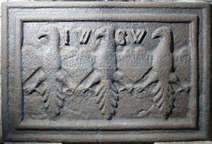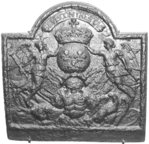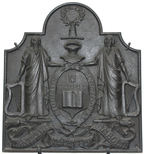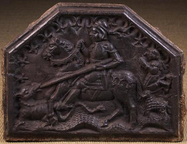-
1160
Description: Rectangular, with double astragal edging; three eaglets, their wings outspread, side by side; the initials IW and SW, respectively, to left and right of the central eaglet's head.
Notes: The design is based on the arms of Wynn, of Gwydir Castle in the Conwy valley of North Wales, the blazon of which is Vert, three eagles displayed in fess or. The initials relate to Sir John Wynn (1553-1626/7) who, c.1576, married Sydney Gerrard (d.1632), dating the fireback to c.1576-1626. The conjoined wings of the eagles appear to form heart shapes.
Inscription: IW SW
Arms: Wynn of Gwydir
- Decoration tags:
- rectangular (shape)
- astragal (edging)
- whole carved pattern
- individual letters
- heraldic
- text
- animals
Manufactured: in the late-16th to early-17th century in England.
Current location: Gwydir Castle, Trefriw, Conwy, Wales.
- Attached to series:
- Personal firebacks
- Welsh armorial firebacks
-
1264
Description: Arched rectangular central panel with bead edging (top and sides) enclosing a shield, helm, crest, mantling and motto of the Fitch family, descendants of Edwin Frederick Fitch (1839-1916); above the achievement, symmetrical laurel leaves, all within an arched rectangular astragal border surmounted by, on the dexter side, a behelmeted merman holding a scimitar and, on the sinister side, a mermaid holding a mirror; top centre, three ostrich feathers gathered with a ribbon.
Notes: A pastiche of the 17th century Carolean 'Dutch' series (e.g. no. 280). Blazon: Vert, on a chevron between three leopards' faces or langued gules, as many cross crosslets fitchee of the last, in the chief point an ermine spot of the second; Crest: Upon a wreath of the colours, a leopard's face erminois pierced through the mouth with a sword broken in the middle argent, pommel and hilt or.
Inscription: FACTA NON VERBA [Actions not words]
Arms: Fitch
Manufactured: in the early- to mid-20th century in England.
Current location: not known.
- Attached to series:
- Personal armorial firebacks
-
761
Description: Arched rectangular; astragal edging with simiulated ribbon pattern; inscription on a banner in arch; crowned roundel bearing the arms of France between two angel supporters carrying trumpets; below, a triumph of arms; on the bottom, a plain extension panel.
Notes: The motto, translated, reads 'Alone against all'; other firebacks bear the motto, 'Victorieux contre tous' (Victorious against all).
Inscription: SEVL CONTRE TOVS
Arms: France modern
- Decoration tags:
- rectangular with round arch (shape)
- astragal (edging)
- whole carved pattern
- extension panels
- armorial
- text
- humans
- objects
Manufactured: in the late-17th century in France.
Current location: Victoria & Albert Museum, Cromwell Road, Kensington & Chelsea, Greater London, England.
Museum number: M.3-1918 (part of the Victoria & Albert Museum museum group)
Citation: Carpentier, H., 1912, Plaques de Cheminées (Paris, published by the author).
- Attached to series:
- Foreign armorial firebacks
-
772
Description: Cavetto canted arched rectangle; astragal edging; oval inscription surrounding a central battlemented shield bearing an open book, with a baronet's escutcheon above; above, a helm with a crest of an arm and hand holding a wreath; on each side, a druid supporter holding a harp, each upon a horizontal fillet; below, intertwined bell flowers behind a tripartite motto scroll.
Notes: The motto appears to have been incorrectly spelled; the Conroy baronetcy was created for Sir John Conroy, comptroller of the household of the Duchess of Kent, and much hated by her daughter, Princess (later Queen) Victoria; the 3rd (and last) baronet succeeded to the title in 1869.
Inscription: FIDELITER ET CONSTANTER [Faithfully and constantly] / L'ANTIQIVITE NE PEVX PAS L'ABOLIR [Antiquity cannot abolish it]
Arms: Conroy, baronet, of Llanbrynmair (Sir John Conroy, 3rd baronet, 1845-1900)
- Decoration tags:
- rectangular with canted top corners and round arch (shape)
- astragal (edging)
- whole carved pattern
- armorial
- text
- humans
Manufactured: in the late-19th century in England.
Current location: Victoria & Albert Museum, Cromwell Road, Kensington & Chelsea, Greater London, England.
Museum number: 502.1896 (part of the Victoria & Albert Museum museum group)
- Attached to series:
- Personal armorial firebacks
- Welsh armorial firebacks
-
1063
Description: Composite of three elements; central panel has a complex ‘knot’ pattern with a fillet edge; side panel, repeated on either side of the central panel, contains a vase of flowers, possibly stylised thistles, within an arched frame and fillet edge; arched panel above, also with fillet edge, contains the date and inscription; the spandrels of the side panels, and the arched top panel, contain a series of circular motifs comprising concentric rings deepening towards the centre.
Notes: ‘Knot’ patterns were popular in gardens of the period. The garden theme is continued with the side panels. An example of the same design, noted at Linchmere, West Sussex, is a different casting, the top panel with the date and initials being slightly askew. From a photograph in the Victoria and Albert Museum, London; photographed at Mapesbury House, Willesden in 1904.
Copies of this fireback are known.
Inscription: 1598 / IM IB
- Decoration tags:
- rectangular with round arch (shape)
- astragal (edging)
- carved pattern panels
- text
- plants
- objects
Manufactured: in 1598 in the Weald area of England.
Current location: not known.
Museum number: E.4376-2000 (part of the Victoria & Albert Museum museum group)
- Attached to series:
- Armada series
- Garden design types
-
790
Description: Rectangular with arched rectangular shaped top joined by cavetto curves; astragal edging; shield, supporters, ducal coronet, motto and garter of the Duke of Dorset: Quarterly, Or and gules, a bend vair.
Notes: Almost certainly the arms of Lionel Sackville KG (1688-1765), created first duke of Dorset in 1720; many different firebacks exist, all with precisely the same armorial stamp.
Inscription: [around shield] HONY SOIT QUI MAL Y PENSE / [on motto scroll] AUT NUNQUAM TENTES, AUT PERFICE
Arms: Lionel Sackville, 1st Duke of Dorset
- Decoration tags:
- rectangular with canted top corners and round arch (shape)
- astragal (edging)
- carved pattern panels
- armorial
- text
Manufactured: in the early-18th century in the Weald area of England.
Current location: in private hands, Whatlington, East Sussex, England.
- Attached to series:
- Dorset arms series
- Personal armorial firebacks
- Sackville firebacks
-
1146
Description: Canted rectangular shape; astragal edging with repeated fleurs-de-lys inside top and side edges; figure of St George impaling a dragon to the left with a lance over an undulating ground, with a kneeling figure above a sheep to the right.
Notes: The mould for this unusual fireback may have been formed using a redundant carved, medieval wooden panel, perhaps from a church. Wilkinson's Auctioneers, Doncaster, 24 June 2018, lot 132.
- Decoration tags:
- rectangular with canted top corners (shape)
- astragal (edging)
- whole carved pattern
- pictorial
- mythological
- animals
- humans
Manufactured: in the 16th century in England.
Current location: not known.
- Attached to series:
- Miscellaneous pattern firebacks
-
802
Description: Arched rectangular shaped; astragal edging (top and sides); mainly symmetrical vine arrangement, emerging from a vase, some fronds ending in an eagle’s head, other in leaves; at top of arch, initials ‘HB’ split by date (reversed) with an additional ‘I’; below, initials ‘AIS’ (reversed).
Notes: Two planklines; ‘HB’ refers to Henry Bell, who acquired Rake Manor, Witley, in 1592. ‘AIS’ refers to Anthony Smith, his nephew and heir, and his wife, Joan (née Hore); the form of the date is confused by the addition of an ‘I’, and the somewhat clumsy arrangement of the inscription suggests that it was added to the otherwise foliate pattern priot to casting. The letter 'H' seems to belong to a different character set
Copies of this fireback are known.
Inscription: H I0361B / AIS
- Decoration tags:
- rectangular with round arch (shape)
- astragal (edging)
- whole carved pattern
- planklines
- pictorial
- text
- plants
Manufactured: in 1630 possibly at Witley Park Furnace in the Weald area of England.
Current location: Rake Manor, Witley, Surrey, England.
Citation: Giuseppi, M. S., 1903, 'Rake in Witley [etc.]', Surrey Archaeological Collections, 18, pp. 11-60.
- Attached to series:
- Personal firebacks
- Miscellaneous pattern firebacks







